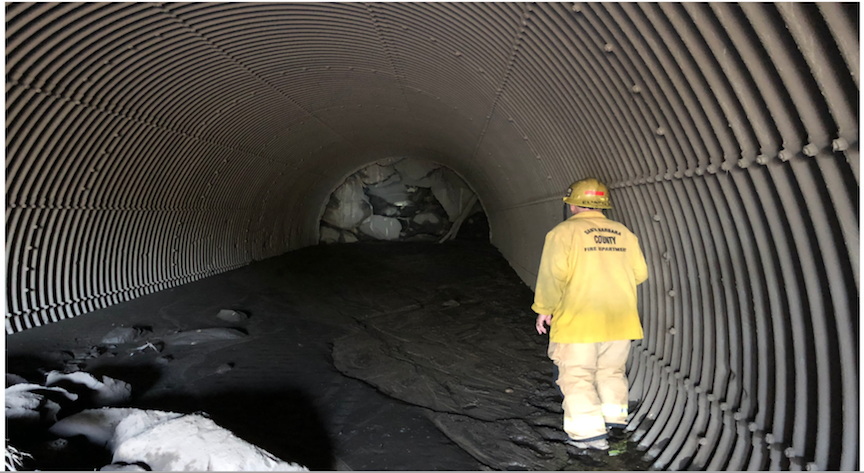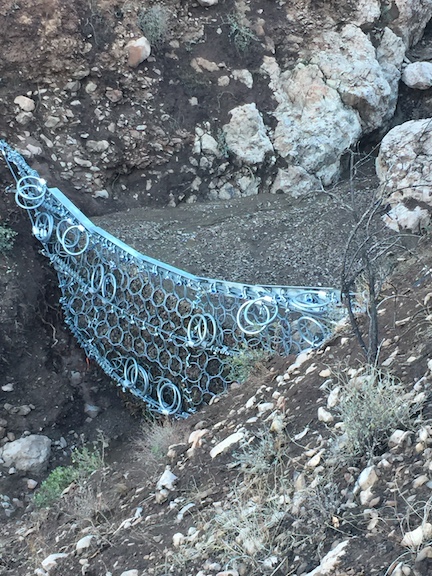Let’s Block the Rocks… Now

The Montecito community faces a difficult 2018-2019 winter season. If we get too little rain, we will return to drought worries; too much rain and Montecito residents face evacuation and the possibility of additional mud and rock flows. Of the two perils – severe drought versus debris flow – the more pressing danger is the fear of a repeat performance of the January 9 debris flow that destroyed or damaged 14% of the residential housing in Montecito.
Present Condition of the Terrain above Montecito
Anyone now hiking Montecito’s trails will confirm that the supply of boulders hanging above our heads today is at least equivalent to, if not greater than, the quantity of boulders and debris that descended upon our sleeping community on January 9. Regeneration of stabilizing vegetation on the mountain in 2018 has been disappointing, due to insufficient water and fire-scorched earth. Hydro-mulching to encourage growth was deemed inadvisable because of the steepness of the slopes. The danger of repeat floods and debris flows remains a community threat for at least the next two to four years.
The National Weather Service has forecast a 65% chance of an El Niño weather pattern this fall and a 70% chance in the winter. Generally, but not always, El Niño weather patterns result in warmer temperatures and higher than average rainfall.
The Partnership for Resilient Communities
The Partnership for Resilient Communities (PFRC) is a Montecito-based, non-profit 501(c)(3) formed to collaborate with the County of Santa Barbara in a public/private partnership to do whatever it takes to avoid a repeat of the January 9 destruction.
PFRC provides a seat at the table for Montecito community leaders to cooperatively offer local and expert opinion as input to the County Recovery Plan. PFRC’s partnership with cash-strapped Santa Barbara County helps to moderate the danger from future natural disasters by expanding the bandwidth of talent and money available to the County.
The all-volunteer team of local residents and founders of the Partnership for Resilient Communities includes Gwyn Lurie, Brett Matthews, Les Firestein, Alixe Mattingly, Pat McElroy, Ron Pulice, Mary Rose, and Joe Cole.
Accomplishments to Date
Previous efforts of the PFRC include examining other similarly distressed communities in Switzerland and Japan; meeting with geologists and technology experts; funding of David Fukutomi, former deputy director of the California Office of Emergency Services (OEM), as a bridge between Montecito and County CEO, Mona Miyasato; identifying “best practices” by direct engagement with James Lee Witt, former head of FEMA; Coast Guard admiral Thad Allen, incident commander for Hurricane Katrina and the Gulf Coast Oil Spill; and consultation with Tom Dunne, Geomorphology, Hydrology Ph.D., Geography at the UCSB Bren School to understand local debris flow hazard areas and risk assessment.
Research in Switzerland led the PFRC team to Dr. William F. Kane, Ph.D., and president of Kane GeoTech, Inc. based in Stockton, California. The firm specializes in difficult geotechnical solutions to slope stability, debris flow, rock slides, avalanches, and instrumentation technology and manufacturing of slope monitoring systems. GeoTech has partnered with European barrier manufacturer GeoBrugg, to build high-tensile steel nets that snare dangerous debris before it damages homes, businesses, and neighborhoods. Successful GeoBrugg nets have been installed in Switzerland, Washington state, New Mexico, Camarillo, California, and other locations throughout the world.
Canyon Ring Nets

The current “hot project” for the PFRC team is the installation on private property of one or more testbed steel netting systems by December 2018 before the onset of winter storms. The December installation time-frame gives the partnership fewer than five months to negotiate contracts with local landowners, including liability protections; navigate through the laborious Santa Barbara County permitting process; and most importantly solicit private funding from Montecito donors to meet the December 2018 installation timetable. Use of a “disaster emergency declaration” may limit the need for CEQA environmental reviews, which could add years, not months, to project approval status.
Funding Requirements
An initial $3.5 million private funding effort is needed to offset the cost to install 18 ring nets in five Montecito canyons by December: Buena Vista Creek; San Ysidro Creek Debris Basin (present capacity 11,000 cubic yards); Cold Springs Creek Debris Basin (present capacity 13,000 cubic yards); Montecito Creek Basin (present capacity 7,000 cubic yards); and Romero Creek Debris Basin (present capacity 15,570 cubic yards).
The new Ring Nets are intended to double the catching capacity of each debris basin by capturing loose boulders, downed trees, and other debris that can clog downstream culverts and bridges creating prodigious overflows. Additional costs would include $700,000 for advanced monitoring systems for all five canyons; $700,000; for engineering plans and permits; and $500,000 for consulting expertise, for a total of $5.4 million, which needs to be raised for this 2018 project.
An additional 27 new Ring Nets would be installed in 2019, adding another 275,000 cubic yards of capacity for boulder and debris retention. Added nets would be installed in the Toro Canyon Upper West Debris Basin (present capacity 8,750 cubic yards); the Toro Canyon Lower West Debris Basin (present capacity 19,545 cubic yards); and the Arroyo Paredon Debris Basin (present capacity 8,360 cubic yards). Hydro-mulching to stimulate hillside vegetation growth would be an additional added expense.
It is hoped that some of the $5.4 million raised in private contributions can be recovered following Ring Net installation through FEMA and other federal and state grant programs, thus providing potential seed capital for additional mitigation measures in later years.
It is anticipated that no money will be contributed by the County of Santa Barbara from capital funds or operating funds in the 2018-19 fiscal year budgets, despite the fact that Montecito homeowners dispatch $104 million to County coffers each year and get back only a small percentage of that amount in services. Unfunded pension and healthcare liabilities for retired County employees effectively bankrupt the County, choking off funding for emergency capital funding expenditures.
Debris Basins and Creek Channel Maintenance
Historically, mountain mitigation has focused more on larger and more sophisticated debris basins as the primary defense against destructive debris flows. Unfortunately, enlargement of Montecito’s six debris basins may be restrained by local topography, cost and time constraints, which makes the easily installed, economically priced Swiss Ring Nets a more viable option for installation this year.
A second restraint on improved debris basins, or even the same ones we have now, is that the County Flood Control has no budget for routine annual maintenance of Montecito’s six inadequate, undersized debris basins, and no capital improvement budget to build larger and more efficient debris basins.
The irony is that the Santa Barbara County Final Updated Debris Basin Maintenance and Removal Plan, published in June 2017 – six months before the January 9 tragedy – stipulated the elimination of two of our inadequate debris basins; “environmentalists” deemed the undersized basins to be a threat to an endangered non-existent fish swimming up a non-existent creek that is perpetuallydry during mating season.Thankfully, after the January 9 disaster, County plans to shut down the San Ysidro Debris Basin and the Cold Spring Basin were quietly shelved over the objections of the federal National Marine Fisheries Services (NMFS) and their environmental friends.
For real protection, what we need are sophisticated debris basins, similar in size to the giant Santa Monica Debris Basin (208,000 cubic yards of flood debris capacity) that saved Carpinteria from a Montecito-like disaster. The Santa Monica debris basin was built in 1977 as a result of major mud and rock flow in Carpinteria in 1969. Construction of the Santa Monica Debris Basin was sponsored by the Carpinteria Valley Watershed Project, with funding grants from the U.S. Department of Agriculture Soil Conservation Service, a forerunner to today’s Federal Emergency Management Agency (FEMA).
It took Carpinteria eight years after its disastrous debris flows of 1969 to plan, fund, and build its enlarged debris basin. How long will it take Montecito to do the same, and at what cost?
Time to Do Your (Our) Part
Interested contributors to the Partnership for Resilient Communities are encouraged to write checks payable to the Santa Barbara Foundation, earmarked for the Partnership for Resilient Communities, mailed to PFRC, P.O. Box 5476, Montecito, CA 93150. Generous donors in Montecito have pledged to match individual contributions up to a maximum of $500,000 to kick-start the campaign.





